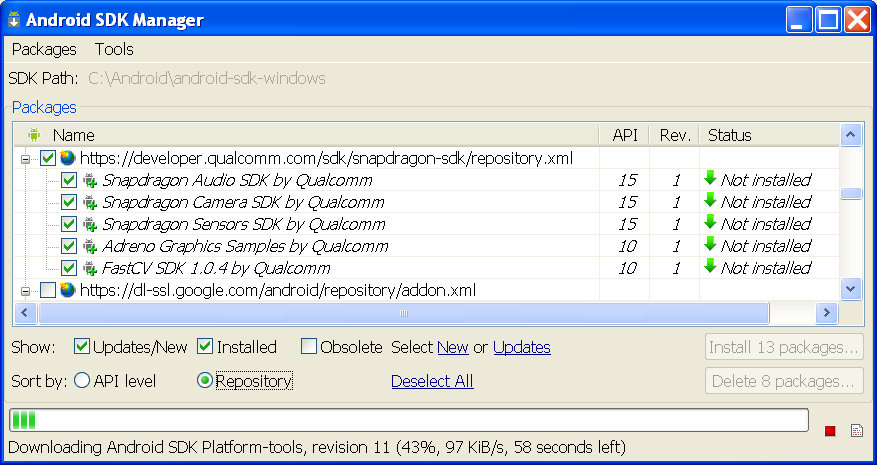Baanto ShadowSense is a new 2D and 3D tracking technology using sensors that allow the system to determine the relative angle and as well as other characteristics of the shadow cast by an object. The system is provided as a frame with several sensors (4 typically) that you can connect via USB to your computer. It is an USB HID device, does not need drivers and support Windows XP/7, Linux and Android. This proprietary technology has the following key features: Traceability of multiple points or objects simultaneously (up to 5 points) Up to 10,000 fps. 16 MPixel resolution of shadow position. Simple algorithm that can be implement in 8-bit MCU. Low power draw. Less than $10 US per sensor. A typical configuration uses 4 sensors and plenty of small LED emitters as shown the illustration. Up to 1mm resolution of object position. No optical lenses are required The resolution is […]
Qualcomm Announces Snapdragon SDK 1.0 for Android
Qualcomm has announced the Snapdragon SDK for Android at the Uplinq 2012 developers conference, and a preview release of the SDK is now available on Qualcomm’s developer site. The full SDK will be available to device manufacturers and developers in the coming months. The Snapdragon SDK for Android enables developers to features of Snapdragon processors via Application Programming Interfaces (APIs) not otherwise available in the stock Android SDK including: Snapdragon Audio SDK (new) Snapdragon Camera SDK (new) Snapdragon Sensors SDK (new) Adreno GPU sample code for OpenGL ES FastCV SDK – Mobile-optimized Computer Vision (CV) library Supposedly, there is also IZat Location SDK, but it did not show up in the list when I tried it. At first, the SDK will only support devices build around Snapdragon S4 8960 processor, but the company expects to support future Snapdragon processors over time. The Snapdragon SDK for Android allows developers to take […]
Motomic Butterfly Media Grid Renders Pictures and Videos on Freescale Kinetis K70 Cortex-M4 MCU
Motomic has officially announced Butterfly Media Grid, the first media player for Cortex M4 micro-controllers. The software currently runs on Freescale MQX Real-Time Operating System, and can display pictures and logos, as well as play videos on micro-controllers such as the Freescale Kinetis K70 MCU. Here are Media Grid key features: Display images, logos and videos Configure from full screen to grids up to 10×10 Rotate content Configure to optimize performance Display at resolutions up to HD Update over a network. Media Grid is available as a standalone application, and an SDK is also provided in order to embed the technology in custom applications using C, C++ or Qt interfaces. Since the media can be updated over the network, Media Grid is actually similar to a simple digital signage player for low end hardware. Motomic showcased the Media Grid at Design West, in March 2012, and only recently uploaded a […]
The Future of ARM Linux by David Rusling, Linaro CTO
David Rusling, Linaro CTO, gave a presentation about the future of ARM Linux at Linaro Connect, in Hong Kong, at the end of May, where he discussed the current status of ARM Linux for mobile, consumer and enterprise markets, the future of ARM Linux and Linaro involvement. He started by saying what he wants personally: A mobile phone that can’t be easily hacked, with 10 hours of battery life for any kind of applications and data must be synchronized in the cloud. The second slide entitled “Future”, but it looked like more the present to me, addresses 3 markets: Mobile: Android vs. iOS, although Windows 8 is coming Post PC: The desktop fades and laptop/tablet merge (think Asus Transformer) Enterprise: Cooling and Power is key and the enterprise is ready for innovation, meaning it will start using ARM platforms. He then focuses on Linux explaining that Android has been the […]
Collabora and Fluendo Release GStreamer SDK 2012.5 Amazon
Last week, Collabora and Fluendo jointly announced the release of an open source software development kit (SDK ) for GStreamer multimedia framework. The SDK aims at easing the integration of Gstreamer into projects and provides a pre-built version of the framework which is available for Linux, Windows and Mac OS X. GStreamer is used in many Linux applications such as media players (Rhythmbox, Banshee and Amarok), video editors (PitiVi), and media centers such as XBMC among other applications. It’s also often the framework used to play videos on ARM platforms with implementations for OMAP 4/5 and devices compliant with the OpenMAX standard. Gstreamer website has also been updated and provides links to download GStreamer SDK and documentation on the home page. The new documentation looks pretty good with fives main sections: Instructions for installing the SDK on Linux (Ubuntu, Debian and Fedora), Windows or Mac OS. 11 basic and 2 advanced tutorials. […]
Texas Instruments Showcases OMAP 5 GPU Capabilities with GLBenchmark 2.5
In February, Texas Instruments compared the browser rendering performance of its OMAP 5 platform to the Nvidia Tegra 3, and the benchmark results showed OMAP 5 was twice as fast @ 800 MHz than the Tegra 3 @ 1.3 GHz. Today, they’ve uploaded a video showing the 3D performance a tablet based on OMAP 5 (and PowerVR SGX 544-MP GPU) against a market-leading tablet (I guess it’s the Apple iPad 3 with PowerVR SGX 543 GPU) using GLBenchmark 2.5 with the following setup: 1080p resolution. On-screen and off-screen tests were conducted to compensate for the “Vysnc Limited” scenarios. (24bpp) 16bit depth tests to better represent high-end game content Power saving mode disabled and device connected to a power source. No background tasks and airplane mode “on.” The on-screen results show 38 fps for the OMAP 5 vs 34 fps for the other platform, or a 12% performance boost. Off-screen results […]
Linaro 12.05 Release with Kernel 3.4 and Android 4.0.4
Linaro has just released version 12.05 based on Linux Kernel 3.4 and Android 4.0.4. This release provides lots of improvement for Origen (Samsung Exynos 4) on Android, further work has been done on big.LITTLE processing and ARMv8 work appears to have started for Ubuntu and Debian. armel vs armhf benchmarks show a massive improvement (up to 15x) when using armhf for povray (3D rendering),. but for most other tests, there is little improvement, and in some rare cases armhf is slightly slower than armel. Here are the highlights of the release: Android Created a stable Google hangout build for Origen Updated DS-5 and gator daemon to 5.10 Stress tests from big.LITTLE testing have been integrated into LAVA Completed big.LITTLE Android tasks Monkeyrunner tests for automating common Android usage have been integrated into LAVA Ordered a new power measurement device from National Instruments Updated and Origen 3.4 rc7 Completed Android HAL […]
Open Source Mali 200/400 Drivers (LIMA) Demo on Android Tablet
Luc Verhaegen, the lead developer of LIMA open source project, provided an update at LinuxTag 2012 last week-end. This open-source MALI GPU driver isn’t ready for consumers yet, but the LIMA team has made some progress and showcased an OpenGL ES demos running on a Chinese tablet running Android. Luc said the tablet used for the demo is the same hardware as the Spark KDE/Vivaldi tablet, so the video demo below must be running on an AMLogic 8726-M processor with a Mali 400 GPU. The drivers already (partially) work on both Mali-200 and Mali-400 GPUs. The fragment shader instructions set is fully known and they have disassembler and assembler fully implement, but they still need to work on the compiler. The vertex shader instruction set is 80% known, they have a simple shader disassembler and are working on the assembler. You can also watch the 40 minute presentation at LinuxTag […]






